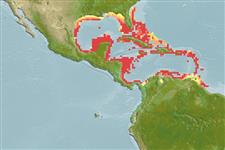Environment: milieu / climate zone / depth range / distribution range
Οικολογία
Θαλασσινό(ά) Υφαλόφιλο(α); μη μεταναστευτικό(ά); εύρος βάθους 1 - 70 m (Ref. 9710). Subtropical; 33°N - 35°S, 99°W - 28°W (Ref. 55265)
Western Atlantic: Florida, USA and Gulf of Mexico to Brazil. Eastern Central Atlantic: St. Paul's Rocks (Ref. 13121).
Length at first maturity / Μέγεθος / Βάρος / Age
Maturity: Lm 22.0 range ? - ? cm
Max length : 45.0 cm TL αρσενικό/απροσδιόριστο; (Ref. 4858); common length : 30.0 cm TL αρσενικό/απροσδιόριστο; (Ref. 3797); μεγ. δημοσιευμένο βάρος: 1.6 kg (Ref. 26340)
Ραχιαίες άκανθες (συνολικά) : 14; Μαλακές ραχιαίες ακτίνες (συνολικά) : 19 - 21; Εδρικές άκανθες: 3; Μαλακές εδρικές ακτίνες: 20 - 21. Tail and pectoral fins entirely yellow. Black spot on forehead has electric blue spots and is surrounded by narrow, electric blue ring. Large blue spot at base of pectoral fin (Ref. 26938). Adults develop short spines on the margin. The color of large adults is purplish blue with yellow-orange rims to the scales; head above eye dark blue, below greenish yellow; mouth, chin, throat, chest and abdomen purplish blue (Ref. 13442)
Found on coral reefs. Generally occurs solitarily or in pairs. Moves gracefully between seafans, seawhips, and corals (Ref. 9710). Stomach contents of 26 specimens indicate that the species feeds almost exclusively on sponges supplemented by small amounts of algae, tunicates, hydroids and bryozoans. Young pick ectoparasites from other fishes (Ref. 9710). Marketed fresh (Ref. 3797).
Life cycle and mating behavior
Γεννητική Ωρίμανση | Αναπαραγωγή | Γεννοβολία | Αβγά | Γονιμότητα | Προνύμφες
Allen, G.R., 1985. Butterfly and angelfishes of the world. Vol. 2. 3rd edit. in English. Mergus Publishers, Melle, Germany. (Ref. 4858)
IUCN Red List Status (Ref. 130435: Version 2024-1)
Threat to humans
Reports of ciguatera poisoning (Ref. 30303)
Human uses
αλιεία: περιορισμένης εμπορικότητας; Ενυδρείο: Εμπορικό(ά)
Εργαλεία
Special reports
Download XML
Διαδικτυακές πηγές
Estimates based on models
Preferred temperature (Ref.
123201): 24.2 - 28, mean 26.7 °C (based on 220 cells).
Phylogenetic diversity index (Ref.
82804): PD
50 = 0.5078 [Uniqueness, from 0.5 = low to 2.0 = high].
Bayesian length-weight: a=0.03162 (0.01614 - 0.06195), b=2.88 (2.71 - 3.05), in cm total length, based on LWR estimates for this species & (Sub)family-body (Ref.
93245).
Τροφικό Επίπεδο (Ref.
69278): 3.0 ±0.0 se; based on diet studies.
Ελαστικότητα (Ref.
120179): Χαμηλό, ελάχιστος χρόνος για διπλασιασμό πληθυσμού 4,5 - 14 έτη (Preliminary K or Fecundity.).
Fishing Vulnerability (Ref.
59153): Low to moderate vulnerability (35 of 100).
Nutrients (Ref.
124155): Calcium = 23.7 [10.8, 43.4] mg/100g; Iron = 0.489 [0.281, 0.849] mg/100g; Protein = 19 [18, 20] %; Omega3 = 0.146 [0.085, 0.251] g/100g; Selenium = 17.6 [8.3, 37.8] μg/100g; VitaminA = 35.8 [8.6, 142.1] μg/100g; Zinc = 0.792 [0.515, 1.183] mg/100g (wet weight);
